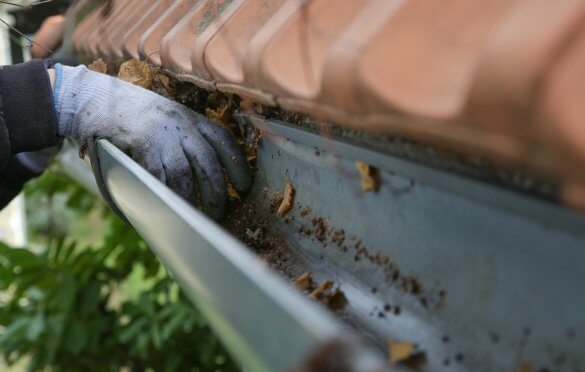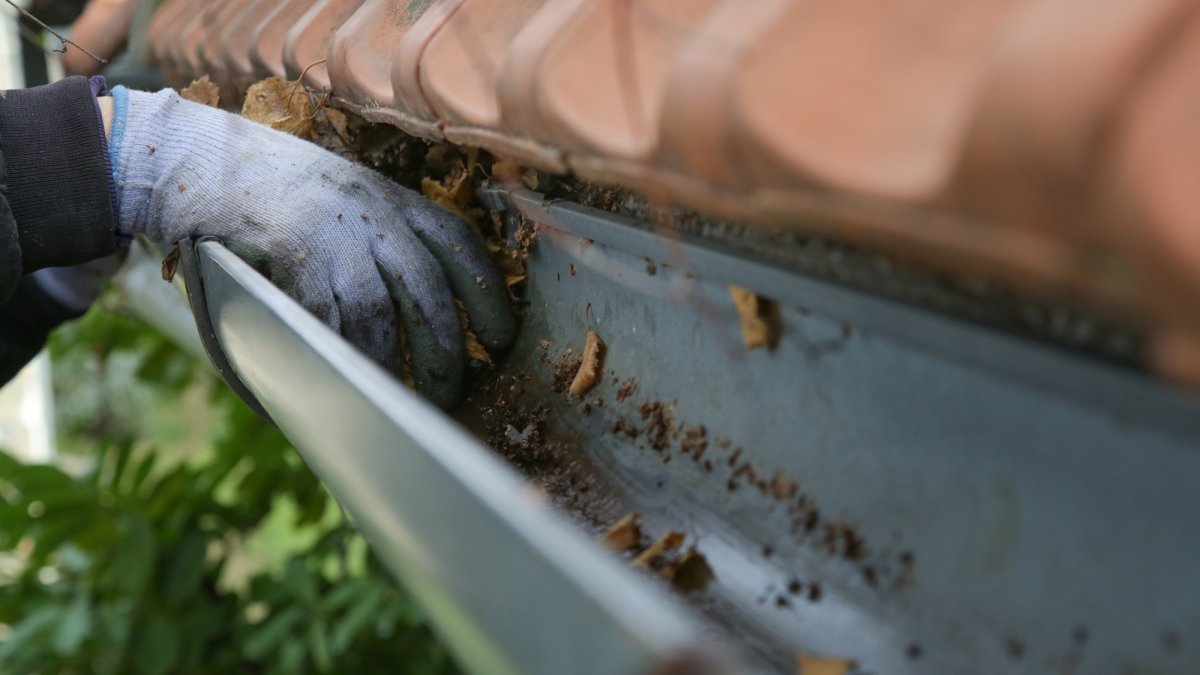
Gutters and downspouts are integral to your home’s exterior, vital in channeling rainwater away from the structure and preventing water damage. These components work together to form a drainage system that safeguards your roof, walls, foundation, and landscaping from the harmful effects of excessive moisture.
While gutters may seem mundane to home maintenance, their importance cannot be overstated. Neglected gutters can lead to problems such as overflowing rainwater, water seeping into the foundation, and ice dams forming during winter.
Regular gutter maintenance is crucial for preventing these issues and ensuring the longevity and integrity of your home. Here’s a seasonal repair checklist every homeowner should have:
Spring
Spring is an ideal time for gutter repair and cleaning, as the melting snow and heavy rains can bring down a lot of debris. Here’s a detailed guide on how to inspect, clean, and maintain your gutters during the spring season:
Inspecting For Winter Damage
As the snow clears, the first step in spring gutter maintenance is a thorough inspection. Look for signs of damage, such as cracks, holes, or sections of the gutter that have been pulled away from the house.
Also, check the fascia board to which the gutters are attached; winter storms and heavy ice can cause these to rot or become loose. Documenting any damage with photos is essential, which can be useful for discussing repairs with a professional.
Clearing Out Debris
Over the winter, gutters can accumulate significant debris, including fallen leaves, twigs, and sediment. This debris can clog your gutters and downspouts, preventing proper drainage and leading to water damage if not addressed.
Begin gutter cleaning by equipping yourself with gloves, a gutter scoop, a small garden trowel, and a bucket. Carefully remove debris, placing it in the bucket rather than throwing it on the ground.
Checking For And Repairing Leaks
After clearing the gutters of debris, it’s essential to ensure they are clean and watertight. Leaks can lead to water damage on your home’s exterior and foundation. Check for leaks by running water through the gutters with a hose. Watch for any drips or wet spots that develop below.
Small leaks can often be repaired with a sealant or patches, which can be done as a DIY project or by a professional. For more significant issues, sections of the gutter may need to be replaced. This may require professional help, especially if the gutters are high or the damage is extensive.
Summer
In summer, gutters are most likely clogged due to increased rainfall and shedding leaves and other debris from trees. Therefore, monitoring your gutters and downspouts closely during this time of year is essential.
Ensuring Proper Water Flow
The primary function of gutters is to direct water away from your home’s structure. To ensure they perform this task effectively:
- Conduct a thorough cleaning to remove small debris, such as seeds, pollen, and dirt, that can build up over time. This debris may not wholly obstruct the water flow but can slow it down significantly, causing overflow during heavy rains.
- After cleaning, use a hose to run water through the gutters to check for proper flow and ensure no hidden blockages.
- If water is not flowing freely, investigate and rectify the issue immediately.
Proper water flow ensures that there are no blockages, rust, or water seeping into the house.
Inspecting for Rust And Corrosion
Gutters are susceptible to rust and corrosion, especially if not made of rust-resistant material. Summer is the perfect time to check for these issues because the weather is typically dryer, and you can take your time to inspect and address any problems.
Look for discoloration, flaking metal, or rust spots at the joints and corners where water might collect. If you find rust beginning to form, you can often treat it by sanding it down and applying a rust-inhibiting primer and paint to prevent further deterioration. However, if the corrosion is extensive, you may need to replace sections of the gutter or consider upgrading to a more durable material like aluminum or vinyl.
Fall
Fall is a critical time for gutter maintenance, as falling leaves and twigs can quickly clog gutters and downspouts, leading to various problems. Key maintenance tasks in fall include:
Removing Leaves And Twigs
As trees shed their leaves in the fall, gutters, including leaves and twigs, can quickly become clogged with debris. This buildup can impede water flow, leading to potential water damage to the roof and house foundation. Regular cleaning is crucial during this season. Homeowners should ensure that they safely and thoroughly clear out their gutters.
Reinforcing Gutter Stability
In preparation for winter, reinforcing the gutters to withstand the weight of snow and ice is vital. Heavy snowfall can lead to gutter sagging or detachment if not adequately secured. Homeowners should inspect the gutter hangers and mounting system to ensure everything is tightly secured and in good condition. It’s also wise to check for any signs of rust or corrosion and replace any weakened sections. Strengthening the gutters in the fall can prevent costly repairs or replacements in the harsher winter.
Gutter Guard Installation
Installing gutter guards can be an effective way to minimize the amount of debris that accumulates in gutters. These guards come in various styles, such as mesh screens, foam filters, or surface tension models, each with pros and cons. When selecting gutter guards, it’s essential to consider the type of foliage around the house, the gutter’s size and style, and the local climate.
Winter
Winter brings its challenges for gutters, as heavy snowfall and freezing temperatures can strain these vital components. To ensure your channels are up to the task, here are some essential winter maintenance tips:
Post-Fall Cleanup Strategies
After the fall season, gutters are often filled with leaves, twigs, and other debris. Clearing this debris is crucial to prevent blockages, ice dams, and gutter damage in winter.
Begin by safely removing all debris from the gutters and downspouts. Check for any signs of damage or wear, such as cracks or sagging, which can be exacerbated by winter weather. Ensure that all support brackets are secure, as loose gutters can be damaged more easily under the weight of snow and ice.
Heavy Snowfall And Ice Dam Prevention
Heavy snowfall and the formation of ice dams are significant concerns during winter. Ice dams occur when ice builds up at the roof’s edge, preventing melting snow from draining off. This can lead to water seeping under the roof shingles, causing damage. To prevent ice dams, ensure your attic is well insulated to avoid heat escaping through the roof, which melts the snow unevenly. Additionally, installing heating cables along the gutter and the roof’s edge can help maintain a consistent temperature, preventing ice buildup.
Mid-Winter Check-Ups and Quick Fixes
Mid-winter check-ups are essential to ensure the gutters function correctly throughout the season. During a mild day, inspect your gutters for ice accumulation or any signs of detachment from the house.
If ice is found inside the gutters, avoid chipping at it, as this can damage the gutter. Instead, use calcium chloride ice melt to melt the ice gently. If you notice minor issues like small cracks or leaks, quick fixes like applying silicone caulk can be effective. However, for more significant problems, it’s advisable to consult a professional.
Conclusion
Gutters and downspouts may seem like a small part of your home’s exterior, but their impact on your home’s safety and longevity is significant. Following the seasonal gutter repair checklist ensures your gutters function correctly throughout the year, protecting your home from water damage, structural damage, and costly repairs. Remember, regular gutter maintenance is an investment in the value and well-being of your home.
Andres Walsh
Related posts
Stay connected
- How LoveOn Chat Is Becoming the Most Versatile AI Companion for Digital UsersThe internet keeps shifting toward hyper-personal interaction, and AI companions are at the center of this shift. What used to be simple chatbots are now evolving into emotionally aware, adaptive, and multi-functional digital partners. Among the new generation of platforms, LoveOn Chat is becoming one... The post How LoveOn Chat Is Becoming the Most Versatile […]

